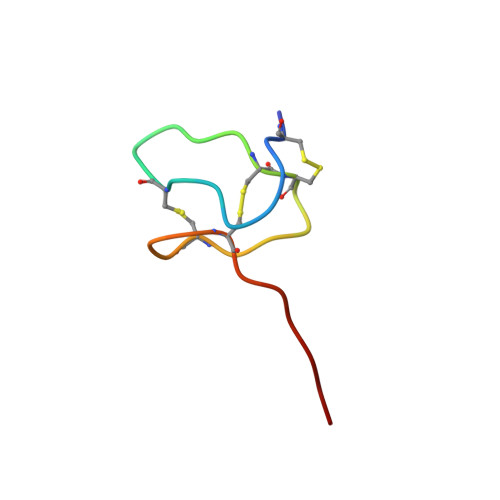Solution structure of peptide toxins that block mechanosensitive ion channels
Oswald, R.E., Suchyna, T.M., McFeeters, R., Gottlieb, P., Sachs, F.(2002) J Biol Chem 277: 34443-34450
- PubMed: 12082099
- DOI: https://doi.org/10.1074/jbc.M202715200
- Primary Citation of Related Structures:
1LUP, 1TYK - PubMed Abstract:
Mechanosensitive channels (MSCs) play key roles in sensory processing and have been implicated as primary transducers for a variety of cellular responses ranging from osmosensing to gene expression. This paper presents the first structures of any kind known to interact specifically with MSCs. GsMTx-4 and GsMtx-2 are inhibitor cysteine knot peptides isolated from venom of the tarantula, Grammostola spatulata (Suchyna, T. M., Johnson, J. H., Hamer, K., Leykam, J. F., Gage, D. A., Clemo, H. F., Baumgarten, C. M., and Sachs, F. (2000) J. Gen. Physiol. 115, 583-598). Inhibition of cationic MSCs by the higher affinity GsMtx-4 (K(D) approximately 500 nm) reduced cell size in swollen and hypertrophic heart cells, swelling-activated currents in astrocytes, and stretch-induced arrhythmias in the heart. Despite the relatively low affinity, no cross-reactivity has been found with other channels. Using two-dimensional NMR spectroscopy, we determined the solution structure of GsMTx-4 and a lower affinity (GsMTx-2; K(D) approximately 6 microm) peptide from the same venom. The dominant feature of the two structures is a hydrophobic patch, utilizing most of the aromatic residues and surrounded with charged residues. The spatial arrangement of charged residues that are unique to GsMTx-4 and GsMTx-2 may underlie the selectivity of these peptides.
Organizational Affiliation:
Department of Molecular Medicine, Cornell University, C3 167 Veterinary Medical Center, Ithaca, NY 14853, USA. reo1@cornell.edu














